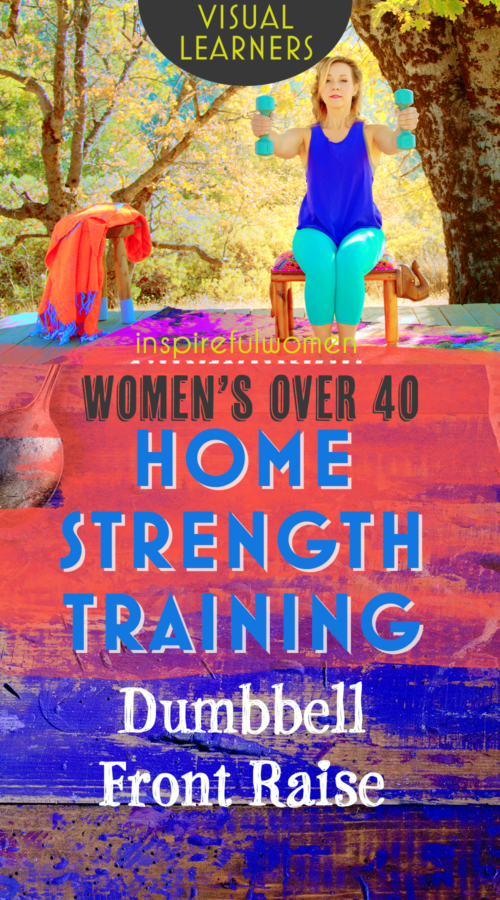Dumbbell Front Delt Raise
How to Do the Dumbbell Front Arm Raise | In-Depth Guide [VISUAL LEARNERS] Beginner
Proper Form, Common Mistakes, Variations + Easier & Harder | Home Resistance Training

WHAT DO YOU WANT TO SEE?
QUICK DEMO
QUICK DEMO
MUSCLES THIS WORKS
MUSCLES
MAIN MUSCLES WORKED IN THE DUMBBELL FRONT Delt RAISE
Anterior DELTOID
OTHER MUSCLES WORKED:
- BICEPS BRACHII
- CORACOBRACHIALIS
- PECTORALIS MAJORIS (upper fibers)
- SCAPULAR MUSCLES
- ROTATOR CUFF to stabilize shoulder joint
- CORE STABILIZERS to hold the upright posture
WHAT WE'RE DOING TODAY
WHAT & WHY
BENEFITS OF TRAINING YOUR Anterior DELTOID MUSCLES
WHAT
WHAT WE'RE DOING TODAY
Other names for this exercise: Front Raise, Front Shoulder Raise, Front Deltoid Raise, Front Arm Raise, Front Lift, Anterior Deltoid Lift
The front delt raise is another very simple movement - don't you just love uncomplicated stuff??
ALL WE'RE DOING:
Lift your arms out straight in front of you, to shoulder height. Now bring them back down.
BAM ladies, you just did a front raise.
This will train the front part of the largest muscle in the shoulder - the deltoid. We (who I am kidding? Not we - I should say they - the sciency workout people - call this front area of the muscle the anterior deltoid. People more like us call it the front delt. Or maybe just the front of the shoulder eh!
Our arms are lifted up until they are level with your shoulders and then slowly lowered back down with control. The front part of the deltoid muscle will work in two different ways:
- while you lift the arm (concentric) and
- also while you lower the arm (eccentric)
WHY BOTHER DOING IT?
WHY
WHY DO WE EVEN CARE?
THIS MUSCLE DOES MOST THE WORK TO MOVE OUR ARMS EVERY DAY
The shoulder has one big muscle that is most responsible for moving the arm - that is the deltoid muscle. This muscle will get help from other muscles - but it does most of the work. Different parts of the muscle will lift the arm in different directions - the front part of the deltoid lifts the arm out to the front of the body. We lift or hold our arms out to the front all day long. Exercising the front deltoid will improve our ability to lift, hold and carry heavy objects.
HELPS PREVENT SHOULDER INJURIES
All of the parts of the deltoid muscle have to work together to protect the shoulder joint from damage, and exercising the this muscle in a safe way can help prevent shoulder injuries.
SAFER WAY TO TRAIN THIS MUSCLE
The front delt raise is one of the easiest and safest exercises for targeting this part of the muscle. This is a great way to train this muscle without raising our arms overhead which tends to become more problematic for women like us over 40. Not saying we shouldn't do it, just that we have to be more cautious about it and it may no longer be the main thing we do all the time.
So because this movement only brings out arms to shoulder height it is a safer position for us, less likely to cause injury or inflammation.
It is also very easy to modify the exercise to make it more or less challenging.
EVERYDAY LIFE
EVERYDAY LIFE &
MUSCLE FUNCTION
HOW WE USE OUR front delt IN EVERYDAY LIFE
1. LIFTING ARM STRAIGHT UP IN FRONT OF BODY (FROM SHOULDER JOINT)
This muscle is used for lifting all items in front of the body when the movement comes from the shoulder (as opposed to bending the elbow) - meaning your elbow is raising into the air to some degree in front of you.
Examples:
- Lifting a jug of milk out of the fridge
- Lifting a pan from the oven
And many renovating skills!
- Spray painting
- Painting walls with rollers & paint brushes
- Slapping on drywall mud to fix those holes in the walls when your grown kids move out.
- Hammering a nail into a wall above you to hang that adorable picture of your 3 year old daughter/ granddaughter.
2. ROTATE ARM INWARD AT THE SHOULDER (INTERNAL SHOULDER ROTATION)
I found this one hard to understand myself when I was first learning it. The best way I can explain it is hold the top of your opposite shoulder with your fingers. The arm of the shoulder you're holding is just resting at your side with your elbow bent. Now move that elbow away from you out to the side/a little to the front. When you do this, what you feel happening with your fingers at your shoulder is your arm bone internally rotating in the shoulder joint.
Examples (if you do these things with moving your elbow outwards):
- Turning a screwdriver
- Turning off a water spigot
- Cleaning - wiping down counters with a sponge where you're moving in clockwise motions.
3. HOLDS ARM BONE IN SHOULDER JOINT AGAINST DOWNWARD PULLS
When the arm is hanging straight down by the side and holding a weight, the deltoid as a whole helps to hold the arm in the shoulder joint against the downward pull of the weight.
If the muscles didn't do this, the weight of what we held could pull the arm bone down in the joint and stretch out the ligaments and soft tissues that help to stabilize the joint. An unstable joint (sloppy movement in the joint) can lead to wear on the bony surfaces, and eventually pain, limited movement and weakness.
Examples:
- Carrying groceries
- Carrying buckets
4. HOLDING ARMS OUT IN FRONT OF YOU FOR SUSTAINED LENGTHS OF TIME
The muscle also holds the arm in front of you for longer periods of time - this is called being in a position of flexion, for activities such as reaching and turning - a key, doorknob, spigot faucet, lightbulb, wrench, screwdriver. Especially when turning the arm inwards at the same time. Also used for carrying items in the front for long periods of time:
- Your kiddo/grandkiddo
- Laundry basket,
- Wheelbarrow
- Boxes held from underneath as we traipse from the living room up the stairs to the attic to keep all those keepsakes forever
HOW TO DO THE EXERCISE
LOOKS
HOW THE Dumbbell FRONT Delt RAISE SHAPEs OUR BODY
Firm and toned shoulders, forms the bulk of the shoulder muscle (along with the lateral and posterior deltoid)
PROPER FORM
PROPER FORM: DUMBBELL FRONT RAISE
EQUIPMENT, SETS & REPS
EQUIPMENT
EQUIPMENT:
2 Dumbbells
SUGGESTED STARTING WEIGHT FOR WOMEN:
5-8 lbs
SETS & REPS:
2 sets, 8 reps each
PACE:
Controlled movement, these are power muscles, can be quick up and slow down, or slow up and slow down depending on goals - it is nice to vary the technique to train both power and endurance.
BODY POSITION
BODY POSITION FOR THE DUMBBELL FRONT RAISE
BODY STANCE: Standing upright with a neutral spine, knees slightly bent, sternum lifted, shoulder blades in and down the back, space between the top of the shoulders and the ear lobe. Chest wide - this is important to avoid rounding the shoulders in. Abdominals gently engaged.
CHEST NOTE: Pay attention to keeping a nice wide chest more than usual because arms are coming straight out in front which will have a tendency to pull other body parts forward and in, so we have to actively resist that pull.
FEET: Shoulder-width apart, toes pointed forward.
ARM: By the side of the body, elbows straight but not locked. You can have a slight bend in the elbow as this can be more comfortable; it's less strain on the elbow joint, but do not move through the elbow during the exercise.
GRIP: Palms face downward (pronated) as they come up holding the dumbbells. To start when the arms are hanging down by the body, the palms will be facing behind you. If you looked down you'd be able to see your knuckles.
NECK: Neutral and relaxed, looking straight ahead.
HOW TO DO
HOW TO DO Dumbbell FRONT Shoulder RAISES
CUE: Isolate the movement to the shoulder joint, keep the chest open/broad.
The movement of our arms comes from the SHOULDER, not the elbow. I'm bolding this because I really didn't use to understand the difference.
Check your posture, activate the core muscles.
Lift your arms straight up to the front of you, keeping the arms straight/only a slight bend in the elbow.
The feeling you want to have as you are doing this is to strive to keep the sternum lifted and the shoulders wide/chest open and let the shoulder blades move freely. Don't let your shoulders round or your upper back cave forward while you're doing this.
The shoulders should not shrug up. The shoulder blades should not be held so tightly down that they are not free to rotate.
The take-home message is to position the shoulder blade and keep your posture good and still but not stiff and rigid.
Lift to until your hands are parallel with the ground (shoulder height), which is 90 degrees of shoulder flexion, and pause at the top.
Lower the weight back down to the side. Begin the next rep.
HOW TO SAFELY GET OUT OF THE EXERCISE
From the beginning position, squat down to set weights on the floor.
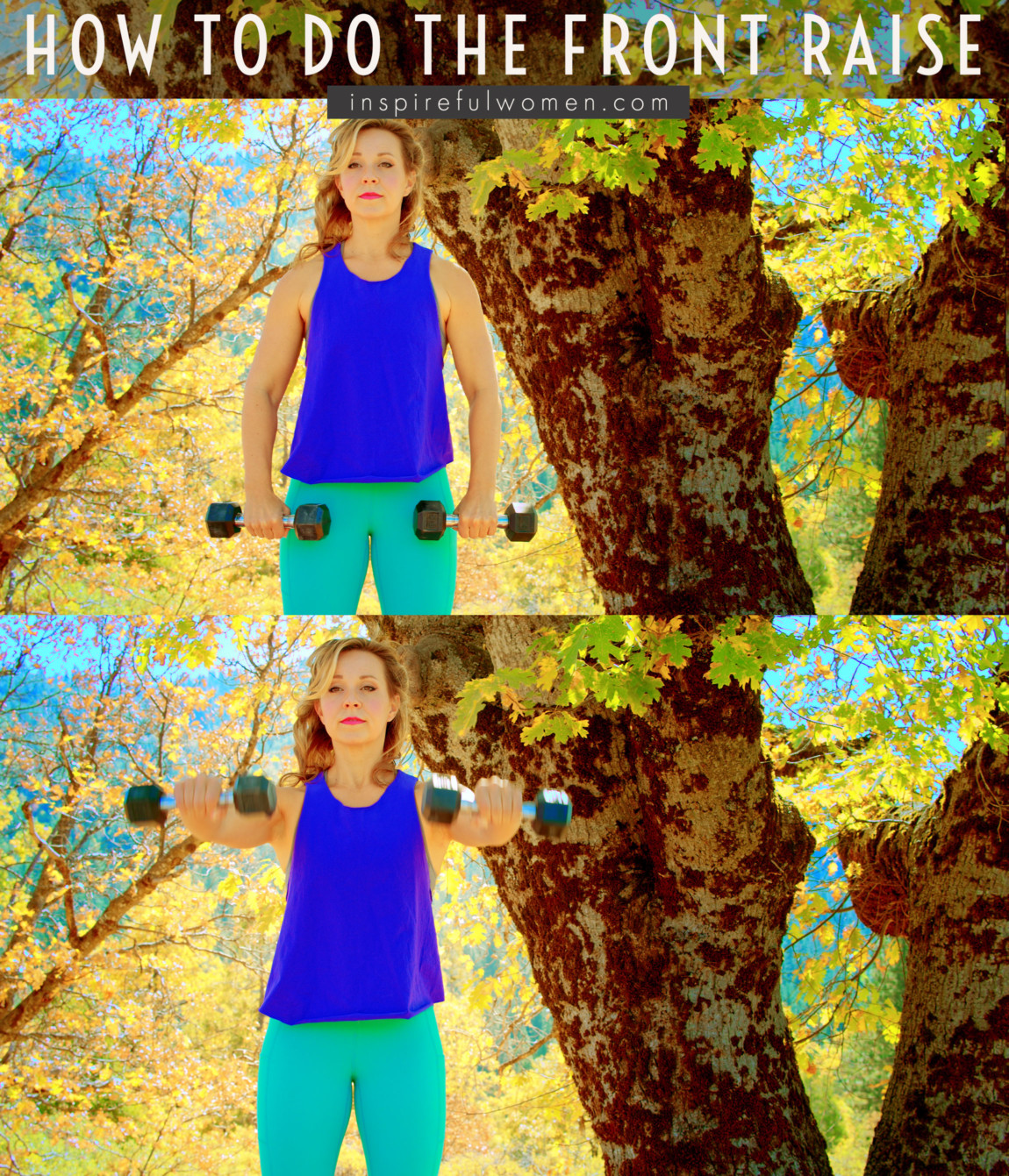
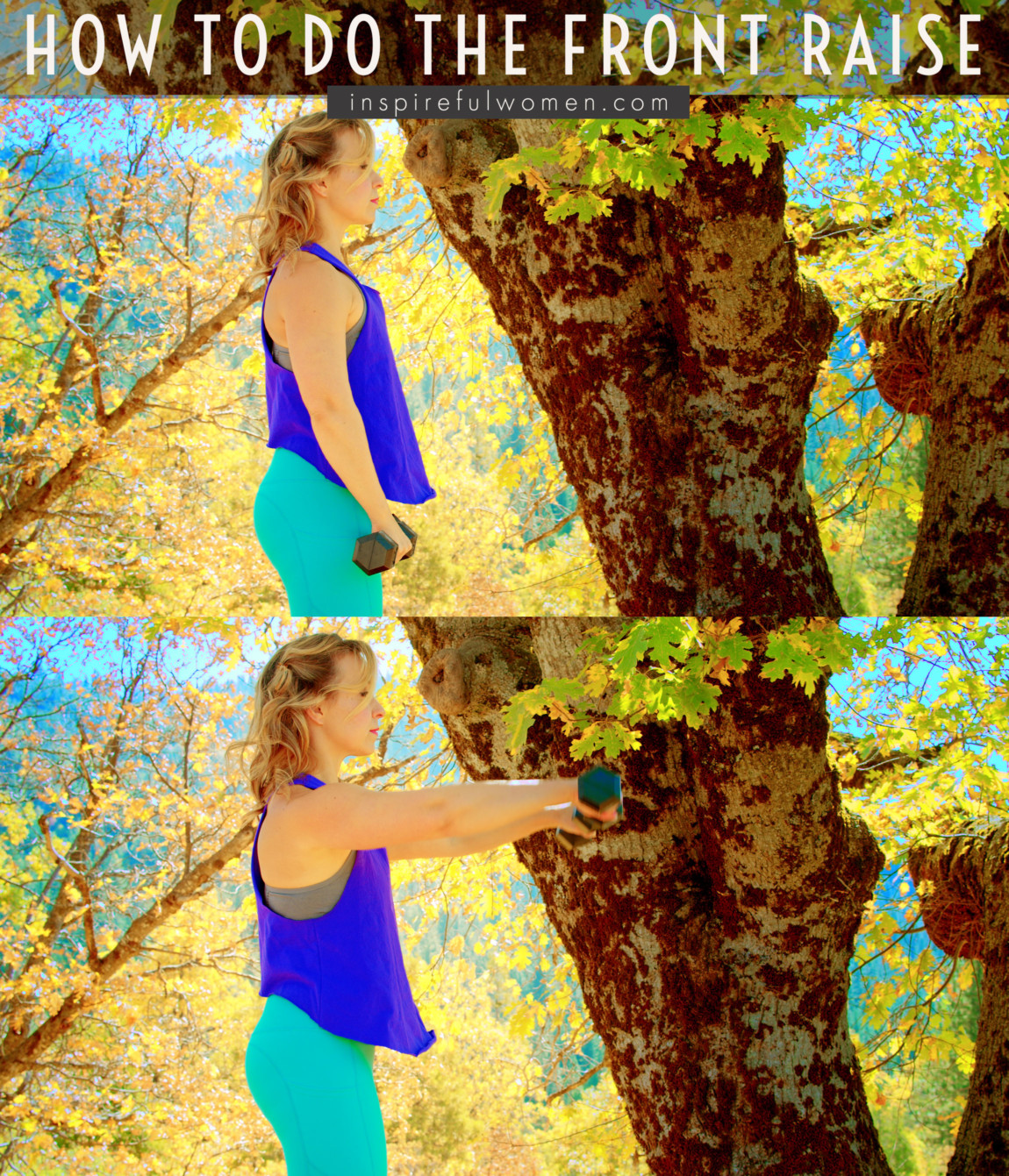
COMMON MISTAKES
COMMON MISTAKES
WHAT TO AVOID WITH THE DUMBBELL FRONT Delt RAISE
KEY TIP:
Guess what? Good news! Many avoids are the same for most movements. Once you learn the basics, there's really only a few extra avoids for each individual movement.
1. Avoid Rounding Shoulders
Avoid letting the shoulder round inwards during the exercise. To fix that, think about keeping your shoulder blades down and back. This helps prevent your rotator cuff muscle - the supraspinatus, and biceps tendon, from being pinched in the top of the shoulder.
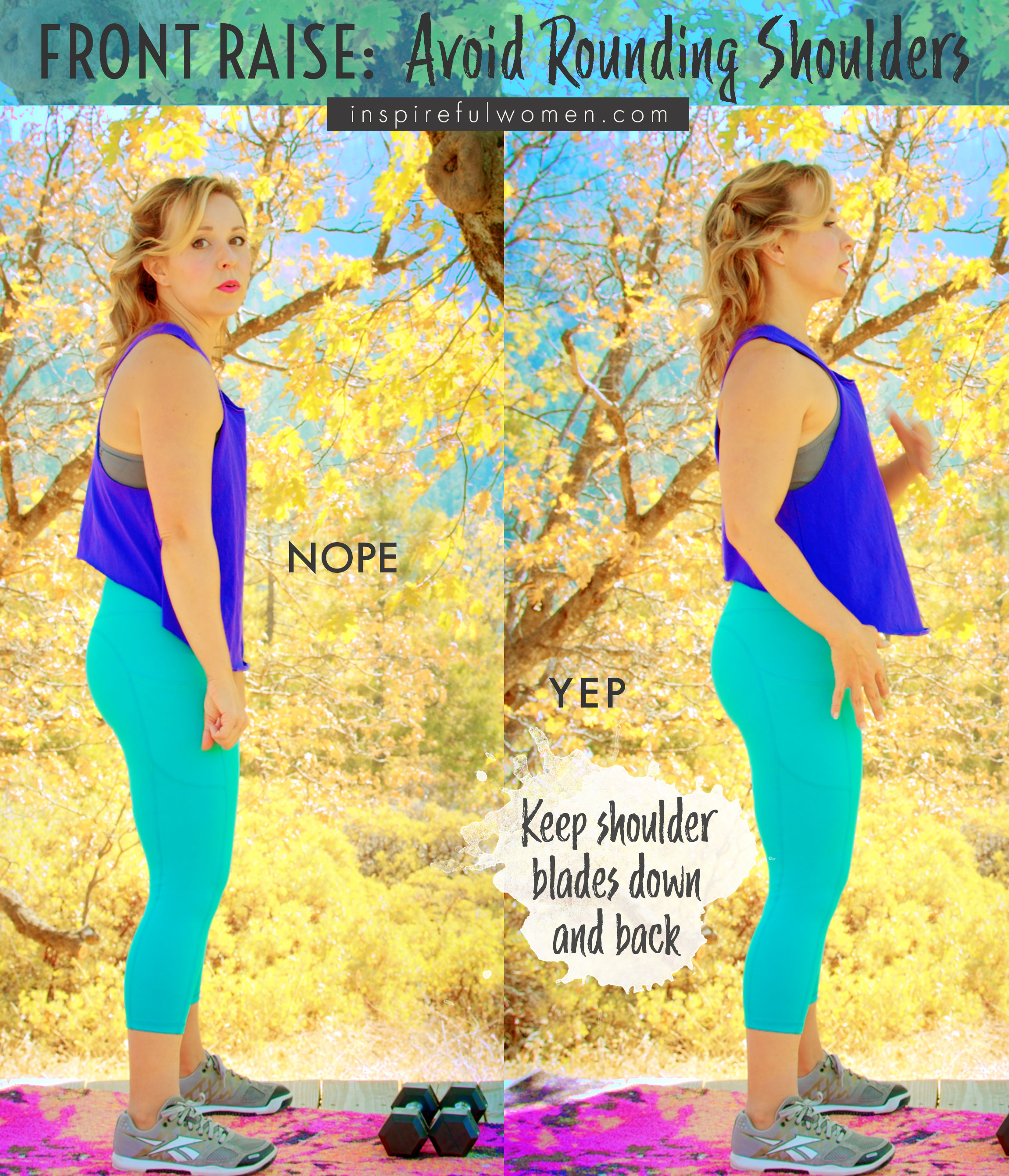
2. Avoid moving Torso front to back or side to side
Avoid moving through the spine; you want the torso to remain still during the entire exercise, so that the movement is only at the shoulder joint.
Moving through the spine repetitively, especially when holding weight, can result in muscle strain, and over time, can damage the ligaments and discs that stabilize the spine.
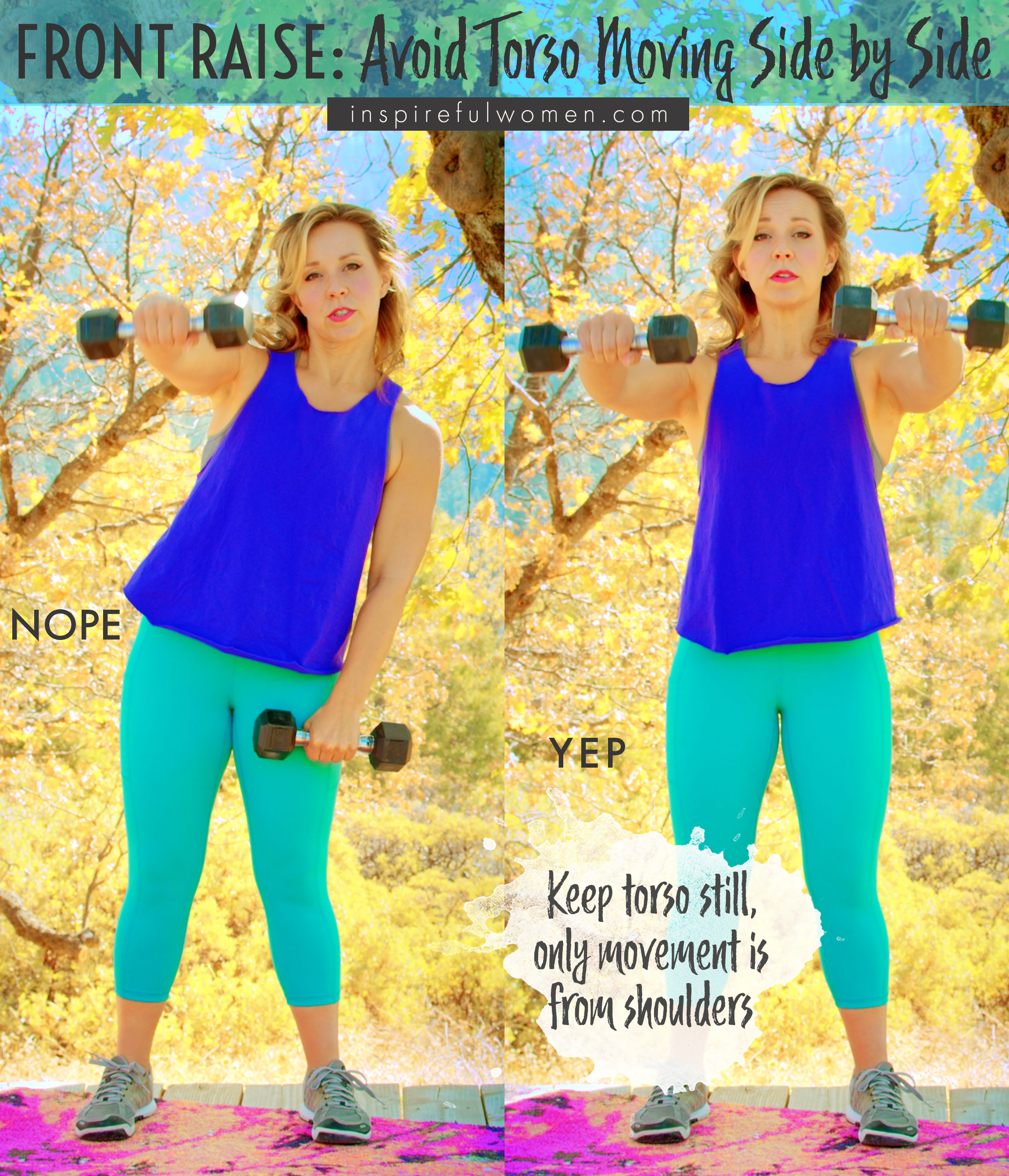
3. Avoid lifting higher than 90° of flexion
Avoid lifting the arms higher than shoulder height. The reason for this is is that after you reach 90 degrees of shoulder flexion, the torque on the shoulder decreases and the risk for impingement increases. The risk of injury outweighs the benefit. All this means is the movement feels easier (meaning it's not working the muscles as hard now), WHILE also being more likely to injure you. So basically a pointless idea eh!
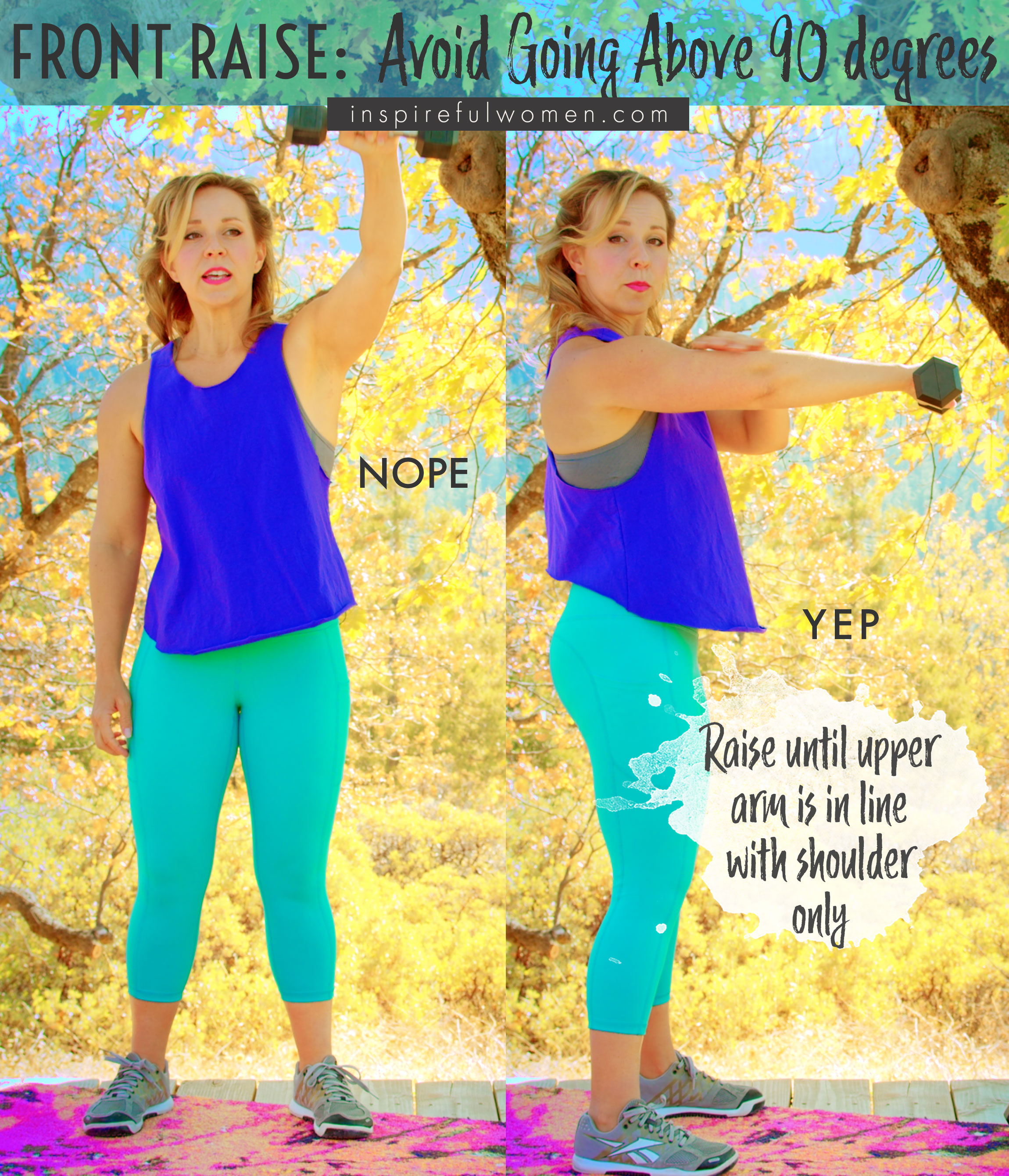
4. Avoid straightening the knees
If we're not thinking about it, we might inadvertently be standing with locked knees during the exercise. It took me while to make standing with a slightly bent knee a habit where I didn't have to think about it.
The reason you don't want to do standing movements with locked knees is that it can pull your low back out of a neutral position. Not maintaining a neutral spine position can lead to injury or muscle strain.
Secondly, it reduces the muscle activity in the legs. Keeping the slight bend in the knees makes it so that what's holding you in this standing position is your actual muscles, not your joints.
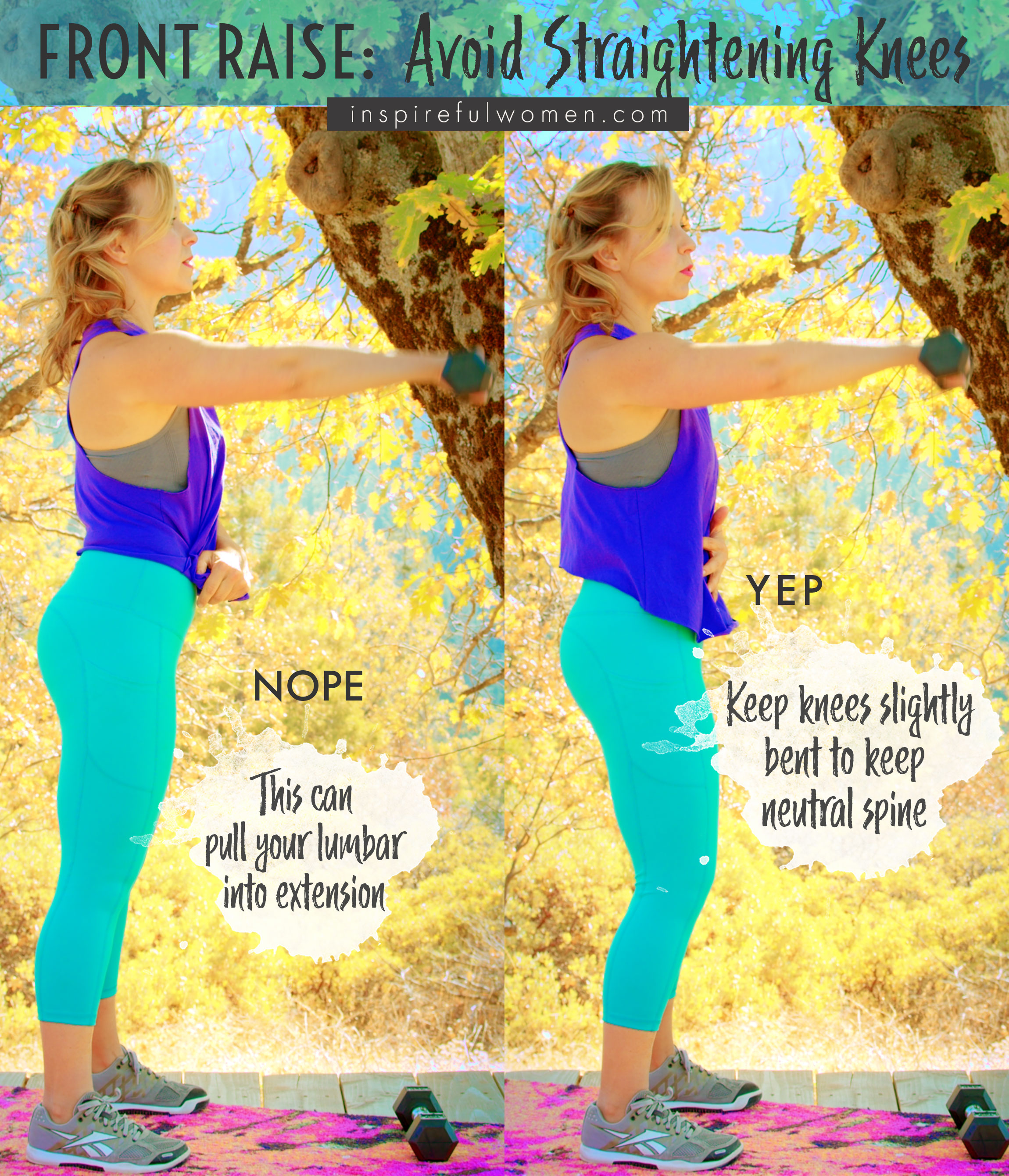
5. Avoid bending wrists
It's very easy to start bending our wrists when we're doing these exercises. The reason to avoid that is it can lead to tissue/joint irritation or damage over time. You want to work at making it a habit to keep your wrist IN-LINE with your forearm as one piece. Like pretending that your wrist can't actually bend. It just goes up with the forearm as one solid piece.

6. Avoid Momentum
Avoid using momentum to swing the arms up and down. Make sure that you can feel the anterior deltoid doing the work to move the arms. In fact, try to think about elongating through your shoulder joint as you lift so you can really feel that muscle working.
7. Avoid not fatiguing muscle
If using too light weights, the muscles are not fatigued by the end of the set. When the form is good, this is a safe exercise for effectively strengthening the anterior deltoid - heavier weights can be used.
8. Avoid using too heavy weights
If you are unable to complete the reps with good form, this can result in using other muscles or strain/injury. Also, be sure to warm up well before doing the final weight you can do.
For instance, I am up to 12 lb dumbbells for this movement but if I go straight to that weight without warming up my shoulders with a lighter weight first, I feel things NOT feeling so great in there and that injury could very easily happen. Warm up well!
9. Avoid Using Other Muscles to Lift
This movement is very easy to start having other muscles take over, especially if the weight is too heavy. You want to feel the area at the front of your shoulder working and burning.
If you let your shoulders raise up towards your ears (shoulder shrugging), this will decrease the activation of the postural muscles (mid and lower back, and core), AND will start using your upper trapezius muscles (located on either side of your neck where your tank top straps would sit).
To avoid that, think about keeping an elongated neck, pressing the shoulders down, and stretching through the shoulder join as you lift up.

VARIATIONS
VARIATIONS
VARIATIONS OF THE DUMBBELL FRONT Delt RAISE
NEUTRAL GRIP FRONT RAISE
Neutral Grip on DB / Hammer Front Raise
A neutral grip aka hammer grip is when you have your palms face each other as you lift up. That is the only difference for this variation.
This is a good option if:
- using a pronated palms-down grip causes any discomfort during or after the exercise
- you have increased kyphosis (thoracic hump) due to osteoporosis
- you have a history of shoulder pain due to osteoarthritis, impingement, or rotator cuff pathology (tendonitis, tendonosis, tears).
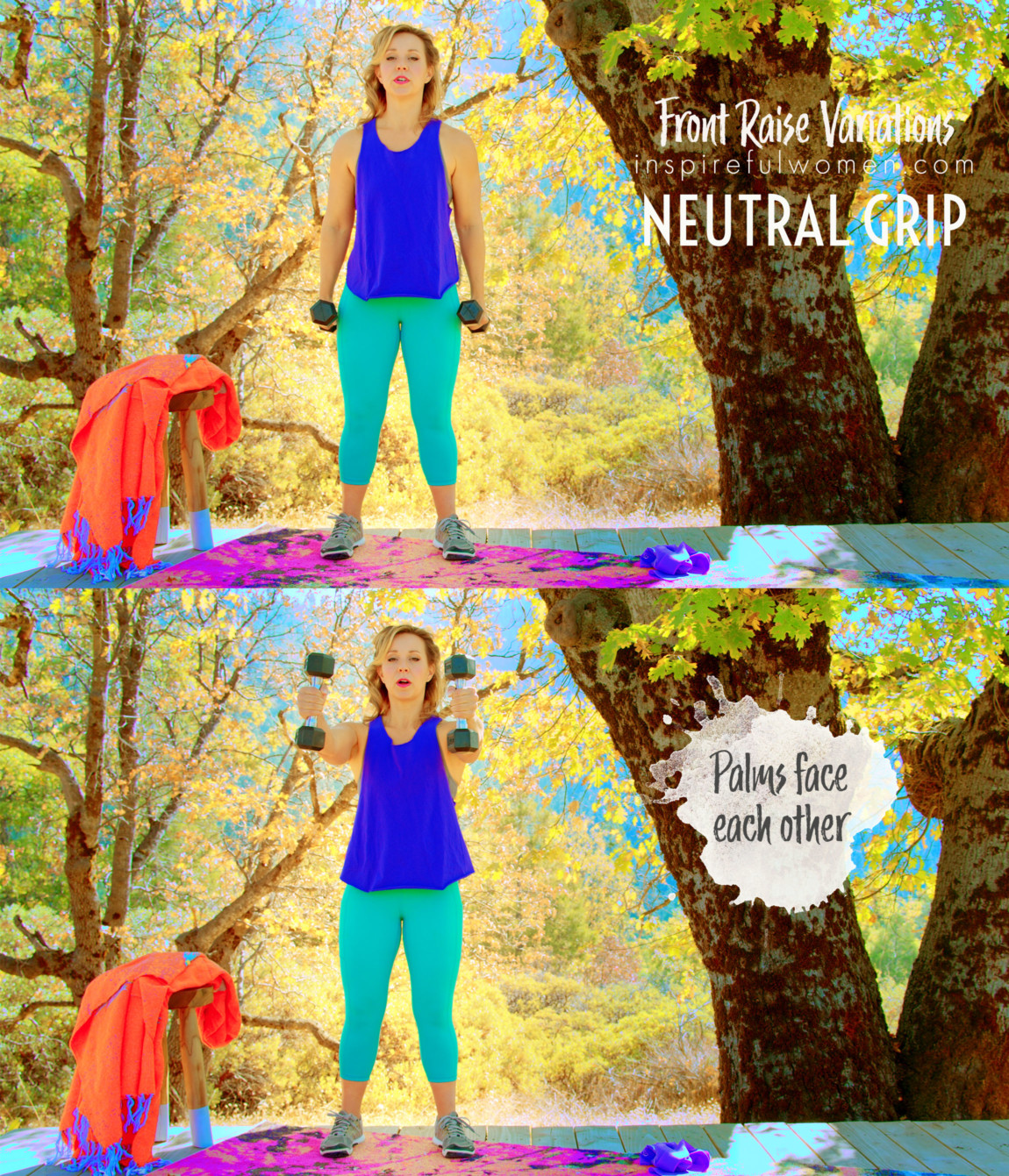
angled Front Raise
Angled Arms
The only change here is that we move our arms out from in front of us, to a bit more out to the side, in what's called the "scapular plane" - this placement of your arms in space is about 30 degrees inward from straight out to your sides (just watch the video, this is hard to write!)
This is a good option if you have any shoulder problems - the position is more functional (the position we use the arm in the most during daily use) and the joint is in a position that provides more space for the soft tissue (less chance of impingement).
Keep the shoulder in a neutrally rotated position (when the forearm is in neutral and the shoulder is in neutral the thumb will be pointed inwards - not towards the back or front). This positioning will work the anterior and lateral fibers of the deltoid muscle - the movement is between flexion and abduction.
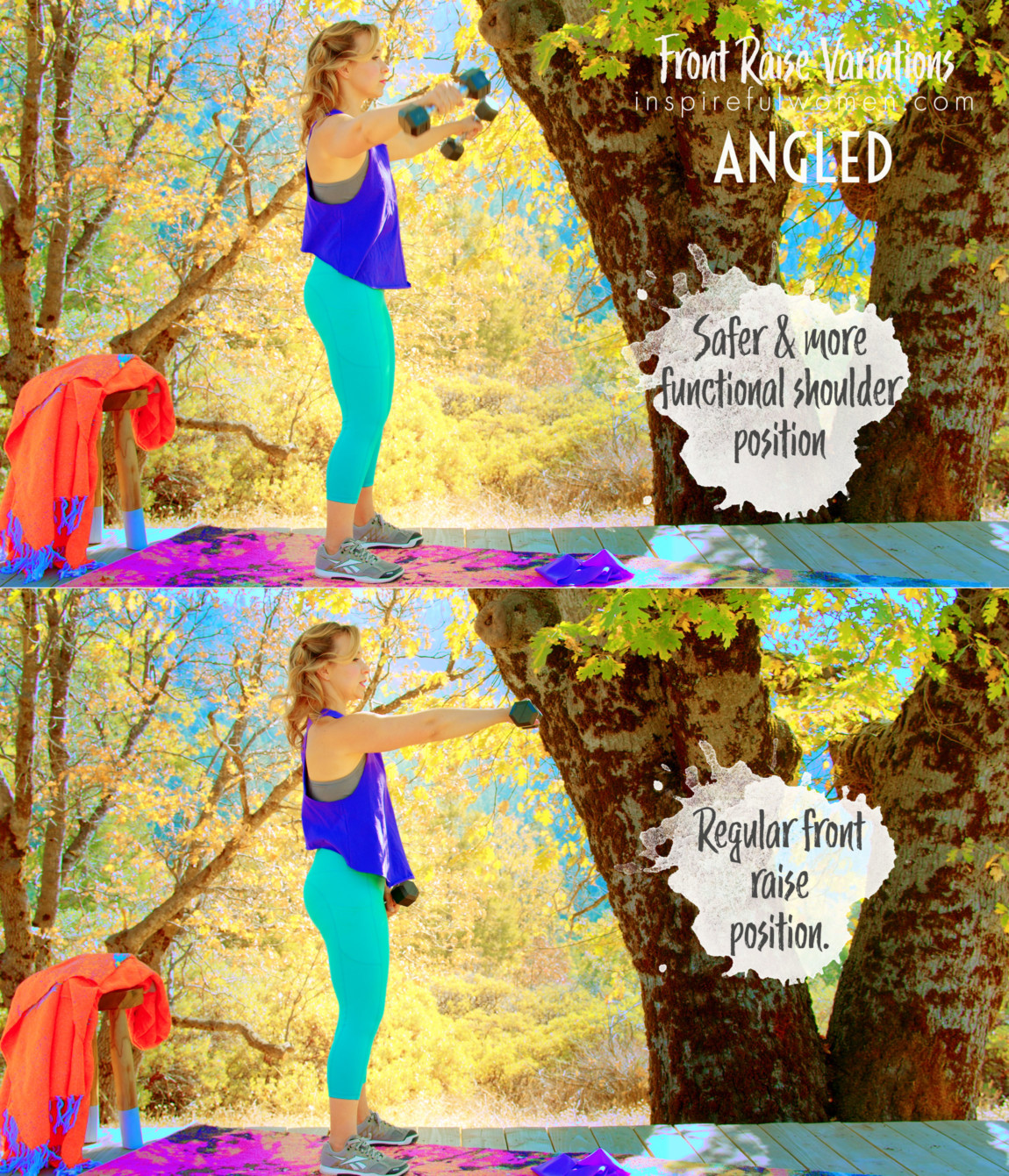
CHEST MUSCLE FOCUS Front Raise
Chest Muscle Focus Raise with Adduction
This variation gets the pectoral (chest) muscles a bit more involved. As you lift the dumbbell up in front of you, you will move the arm on a slight angle towards the middle of your body.
At the top of the movement, your hand should be close to the middle of the chest. This will activate the muscles of the chest (pectoralis major, coracobrachialis) in addition to the muscles that raise the arm up.
It is important to make sure that you are keeping your chest open and your shoulders back - do not round your shoulders or your upper back.
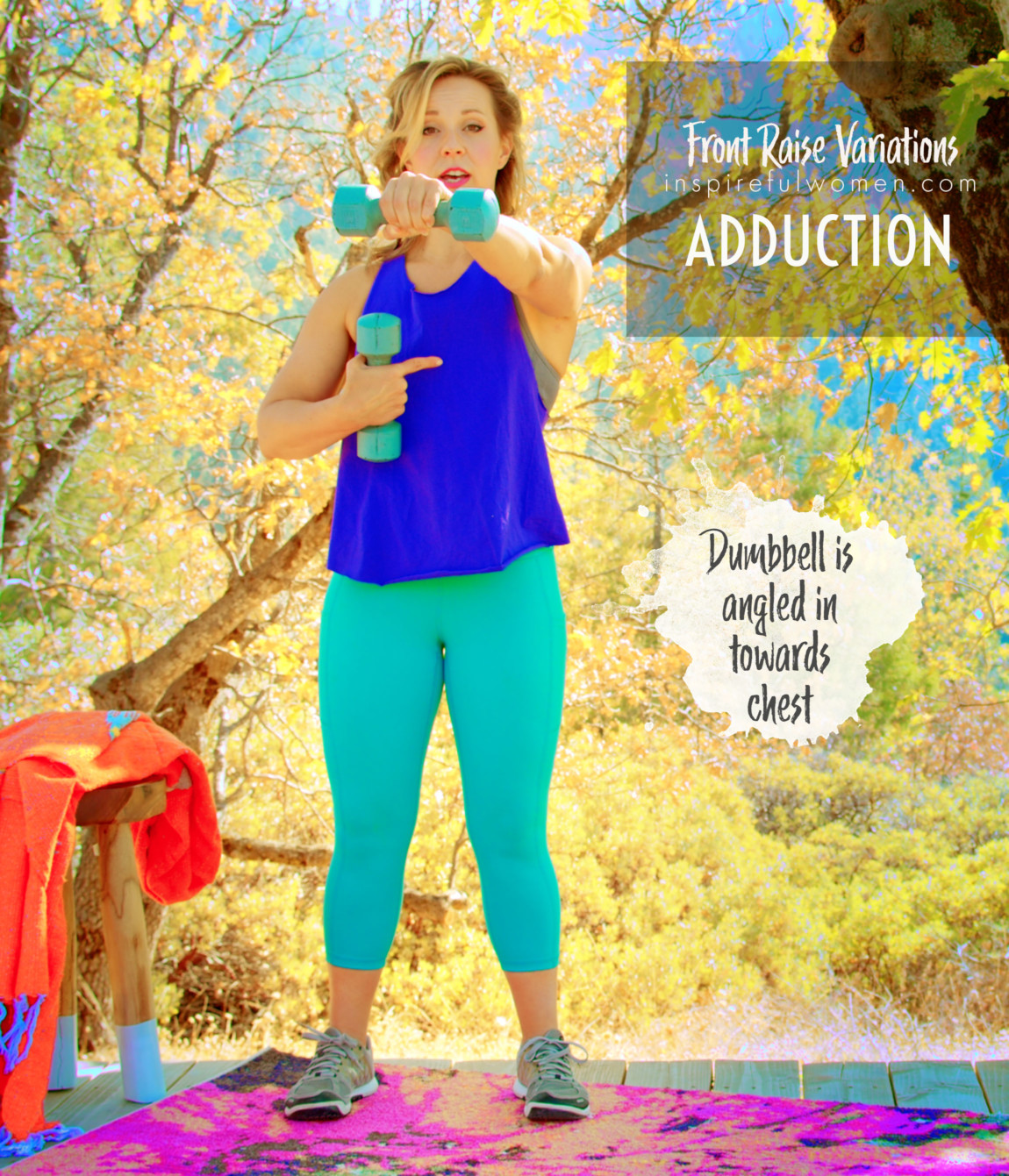
MAKE IT HARDER
HARDER
MAKING THE DUMBBELL FRONT Delt RAISE MORE CHALLENGING
heavier weights
Use heavier weights
Don't be afraid to increase the weight you use if you are ready. The last few reps you do of a set should feel quite hard. You should feel burning in the front of your shoulder muscle. If you don't have this sensation then it might be time to move up the weight. Our muscles can't grow if what we're doing with them doesn't feel very hard.
Slow tempo
Slow eccentric front raise
This involves lowering the weight verrrrry slowly. Take between 5-10 seconds to lower the weight for each rep. Moving upwards will still be the same pace as usual.
This works the muscles differently - they will have to stay active for a longer period of time; trains muscle endurance.
Isometric Front Raise
Iso Hold
Doing isometric holds during an exercise works on muscle endurance, by keeping the muscle under tension for a longer period of time. This also helps to fully fatigue the muscle which we want.
To do an iso hold, pause mid-way and at 90 degrees of flexion (at shoulder height) for 3-5 seconds before lowering the weight.

One arm front raise
Single Arm
One side at a time with dumbbells. This will allow you to focus on one arm and make sure you are feeling the correct muscles working. It will work the core muscles differently - the obliques and the quadratus lumborum will be more active to stabilize against one side of the body being loaded.
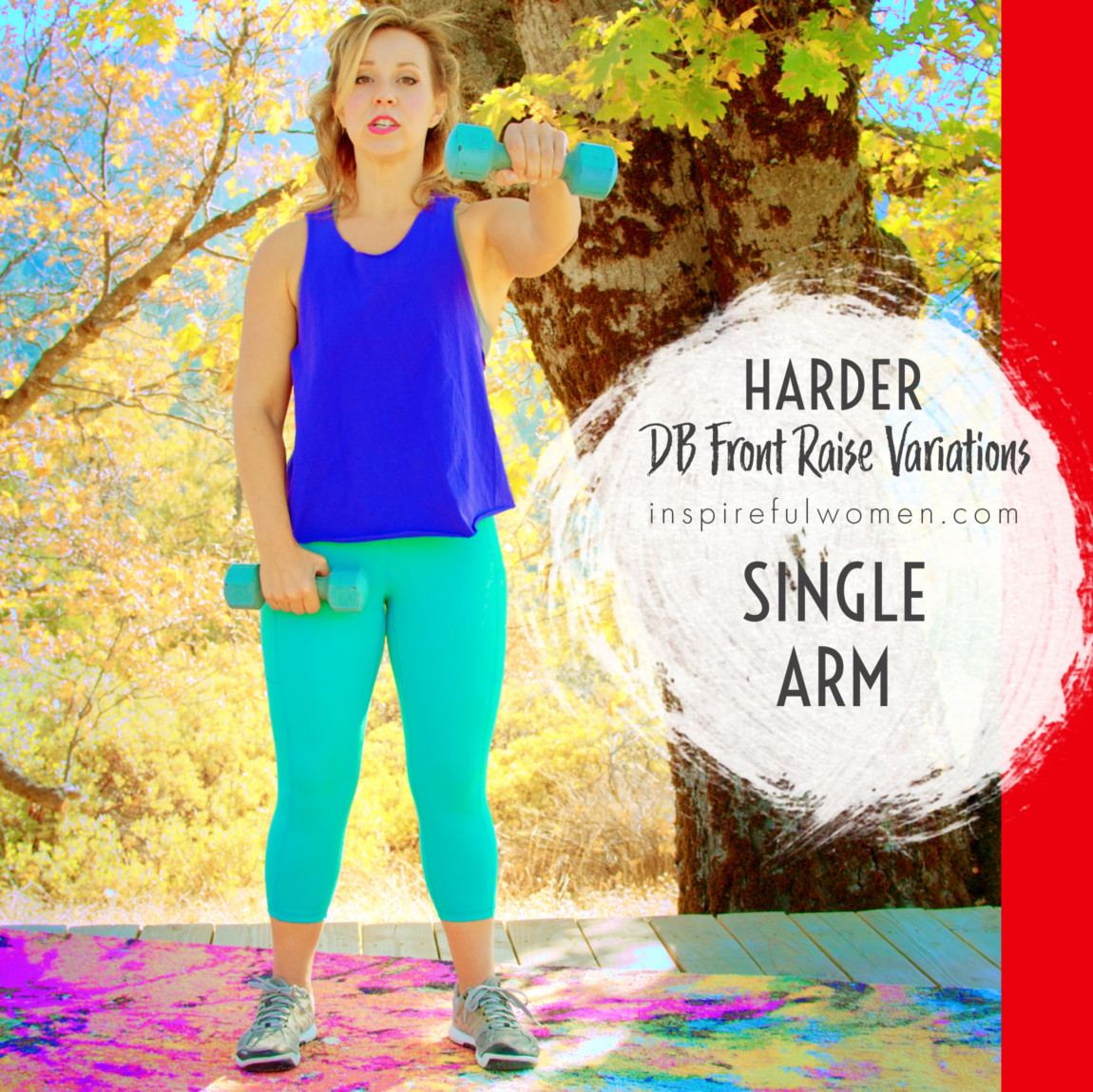
MAKE IT EASIER
EASIER
MAKE THE DUMBBELL FRONT DELT RAISE MORE DOABLE
Neutral Grip
Neutral Grip Front Raise
A neutral grip aka hammer grip is when you have your palms face each other as you lift up. That is the only difference for this variation.
The neutral or hammer grip tends to promote rotation of the upper arm bone (humerus), moving it from slightly internally rotated to a more neutral position. This can be a safer choice for those that experience any discomfort during or after front raises with a pronated palms down grip.
This is a great option for people that have poor scapular control or awareness, increased kyphosis (thoracic hump, slouched posture) due to osteoporosis, rounded shoulders, or any history of shoulder impingement, rotator cuff tendonitis, tendonosis, tears, or osteoarthritis in their shoulder.
There is very little, if any, difference in muscle activation between using a hammer or pronated grip for the front raise exercise. You should use the grip that is most comfortable for you.
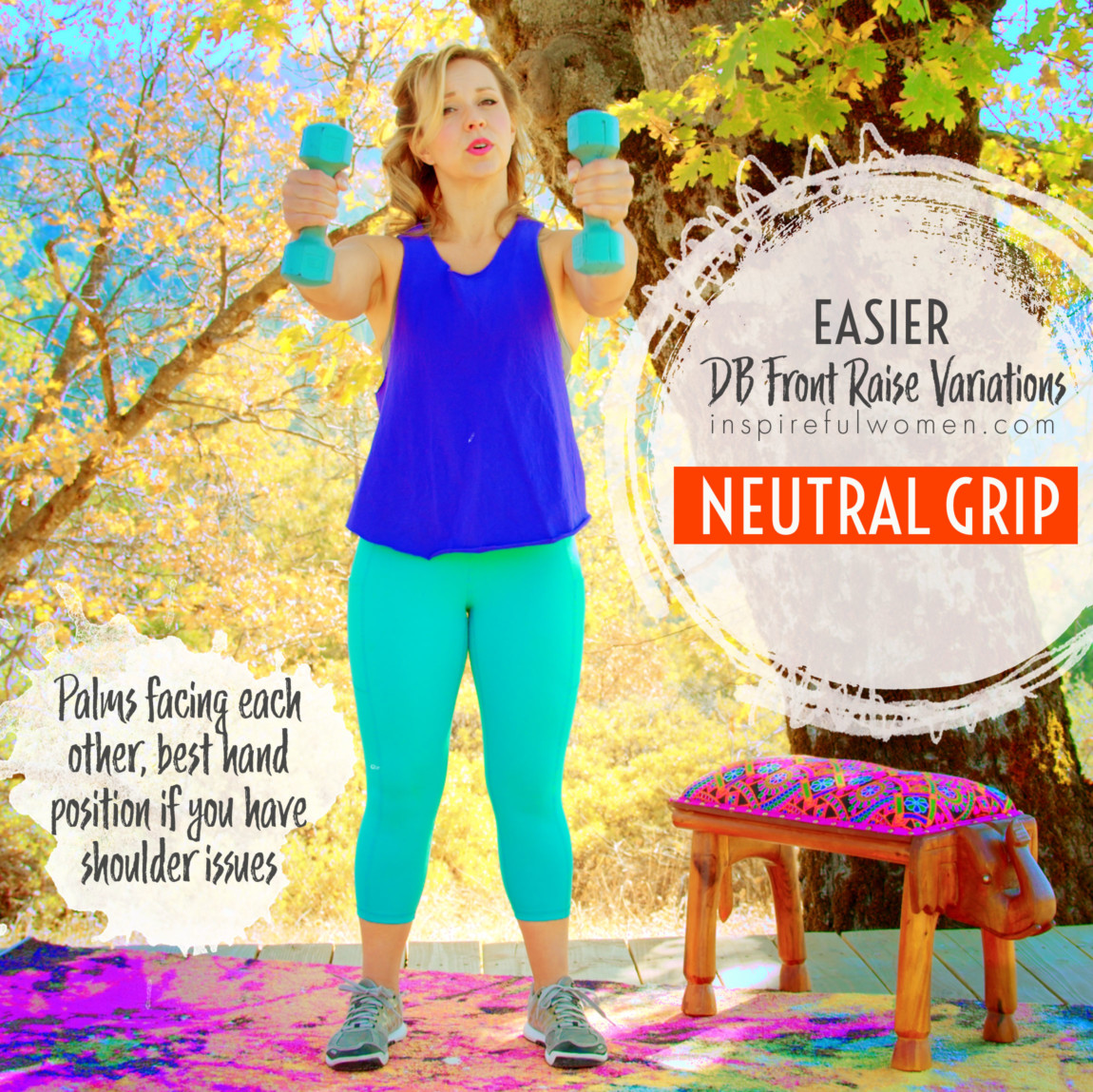
Neutral Grip + Angled
This creates more space in your shoulder joint so it's safer & easier.
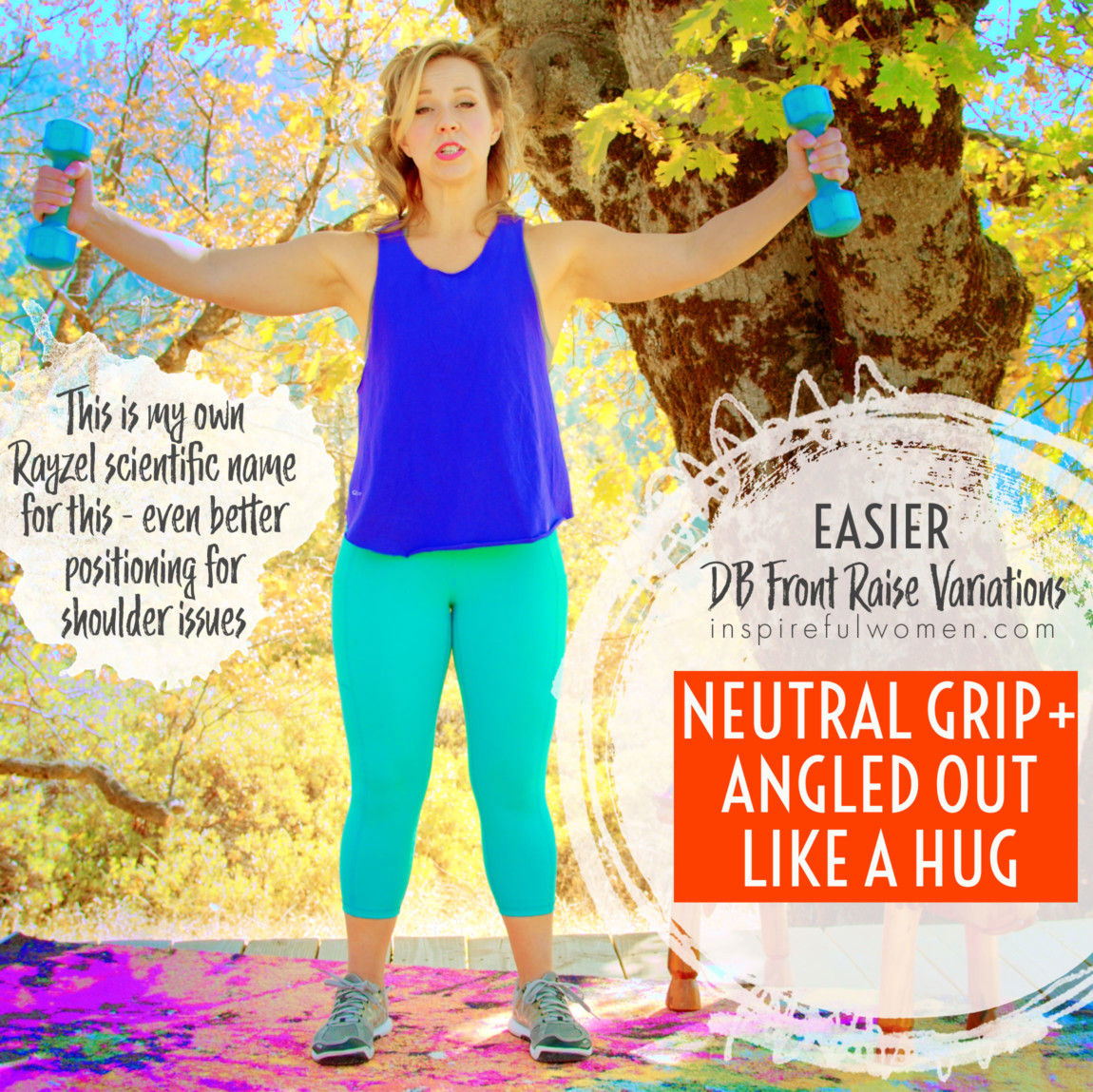
Alternating
Alternate Front Raise
Alternating front raises will allow you to focus on one arm and make sure you are feeling the correct muscles working. It will work the core muscles differently - the obliques and the quadratus lumborum will be more active to stabilize against one side of the body being loaded. This variation can be used in a number of ways:
- To allow each arm a rest between reps: non-working arm remains by your side. Complete one rep with the other side. Rest that arm by the side and complete rep with the other arm.
- To work the anterior deltoid isometrically as well as concentrically and eccentrically. Raise one arm up to parallel with the floor, hold the position. Raise the other arm up to parallel, lower the first arm down, then lower the second arm down.

Single arm
1 Arm at a time front raise
One side at a time with dumbbells . This will allow you to focus on one arm and make sure you are feeling the correct muscles working. It will work the core muscles differently - the obliques and the quadratus lumborum will be more active to stabilize against one side of the body being loaded. Also, a good option if you only have one dumbbell.
This can be done holding the nonworking arm relaxed by the side
Seated Front Raise
Seated Front Raise
This is a good option if you have difficulty with maintaining good posture, or balance. It may allow you to lift heavier weights with the arms because the core will not have to work as hard to stabilize the torso.
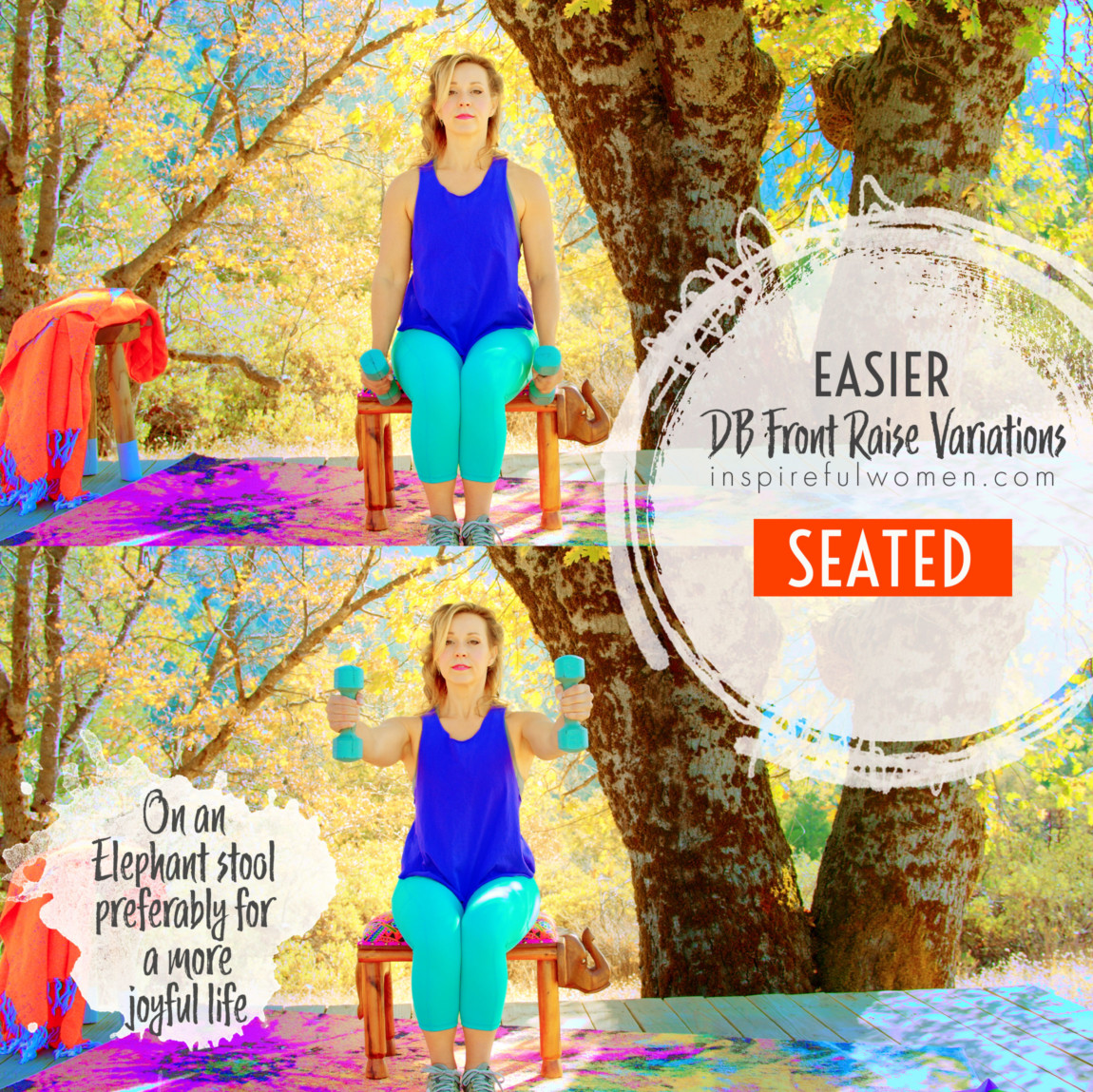
Seated on stability ball
Seated on Stability Ball Front Raise
This is a good option if you have difficulty maintaining good posture, but you would like to work on strengthening your core muscles and improving your balance. Sit on a stability ball with both feet flat on the floor. Put the feet close together to challenge your balance, further apart if you are unable to maintain your balance.
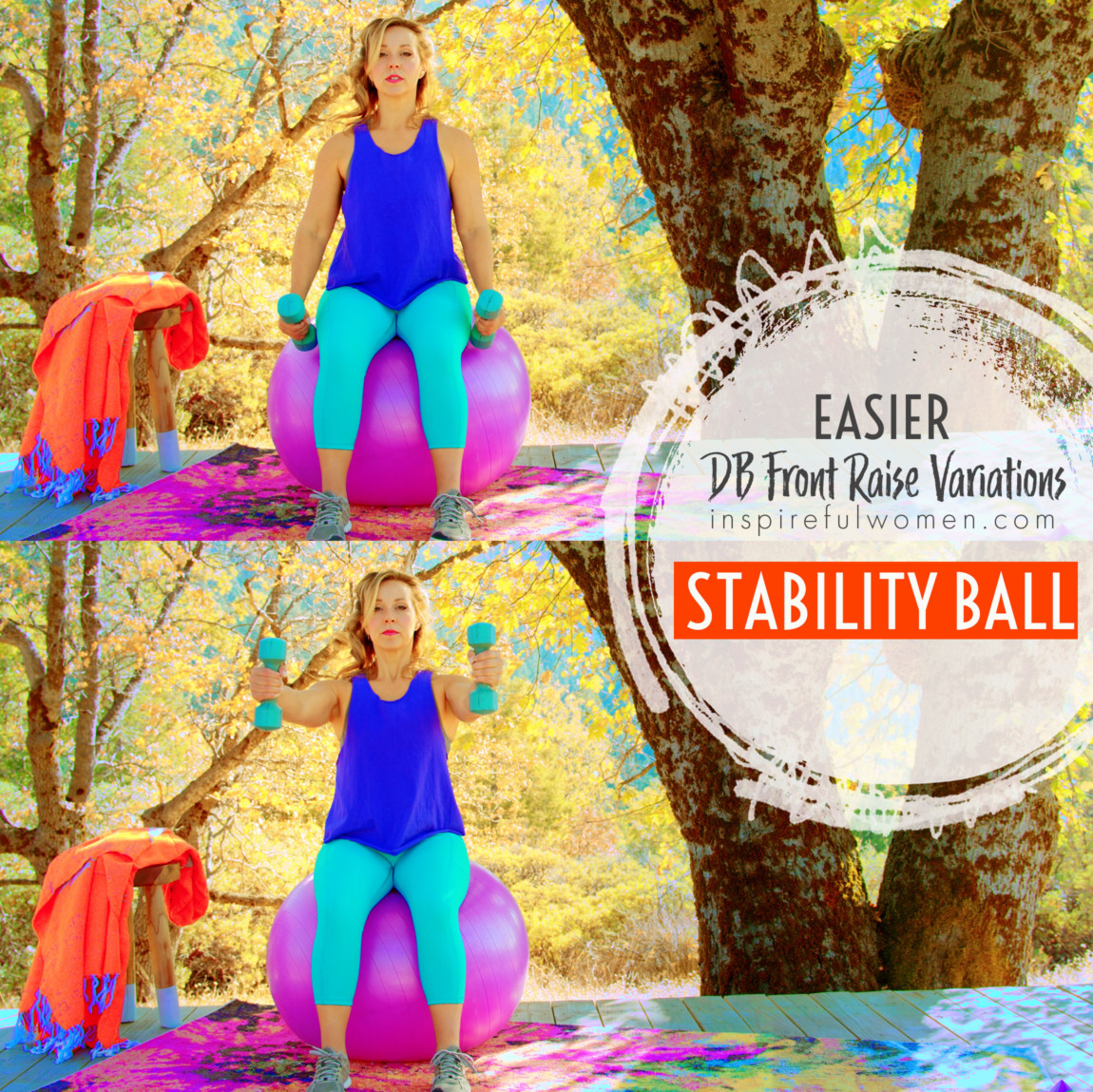
SCIENCY STUFF
SCIENCY STUFF
SPIFFILICIOUS FACTS ABOUT MUSCLES & MOVES
This is a good exercise for isolating the anterior portion of the deltoid muscle. The movement is isolated to the shoulder joint in the sagittal plane (moving straight forwards and back down). In this position, there will be minimal contribution from the pectoralis major, coracobrachialis, and biceps brachii - most of the effort will come from the anterior deltoid.
ALLLL MUSCLES & WHEN
ALL MUSCLES WORKING & WHEN DURING THE DUMBBELL FRONT RAISE
The core stabilizers work to hold the spine in a neutral position throughout the exercise.
The movement of the arms begins with the arm straight down to the side. The scapular stabilizers hold the shoulder blades down and in. The anterior deltoid along with the biceps, coracobrachialis, and upper fibers of the pectoralis major contract concentrically to lift the arm straight up in front of the body, until the arm is parallel to the floor.
The muscles of the forearm will work isometrically to hold the wrist in a neutral position against the downward pull of the dumbbell.
The anterior deltoid, biceps brachii, coracobrachialis, and superior fibers of the pectoralis major work eccentrically to lower the arm back down to the starting position.
PIN IT FOR LATER!


